Google Nexus 9: Preliminary Findings
by Joshua Ho on November 3, 2014 1:00 PM ESTCPU Performance
While there’s a great deal of ground to cover on the tablet as a whole, one of the most interesting aspects of the Nexus 9 is the SoC. While we’ve tested Tegra K1 before, we were looking at the more traditional Cortex A15 variant. The Denver variant (Tegra13x) is mostly similar to Tegra K1-32 (Tegra12x), but instead the CPU cores are a radically different design. In order to get an idea for how this translates into real world we can look at a few of our standard benchmarks in this area, although Google Octane couldn’t complete a full run. This build of Android clearly has AArch64 active, which means that we should be able to directly compare the Nexus 9 to the iPad Air 2 for performance.
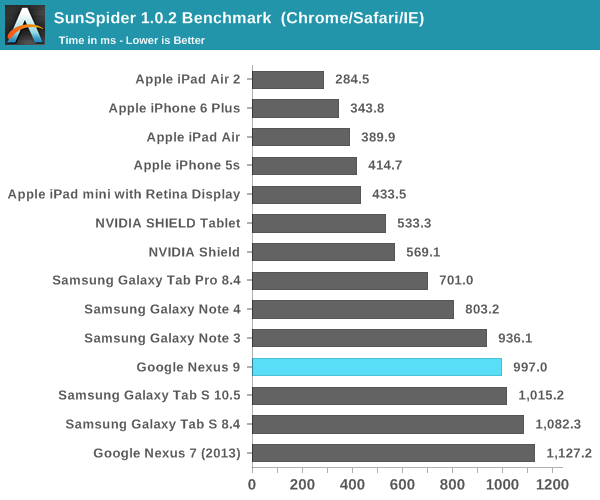
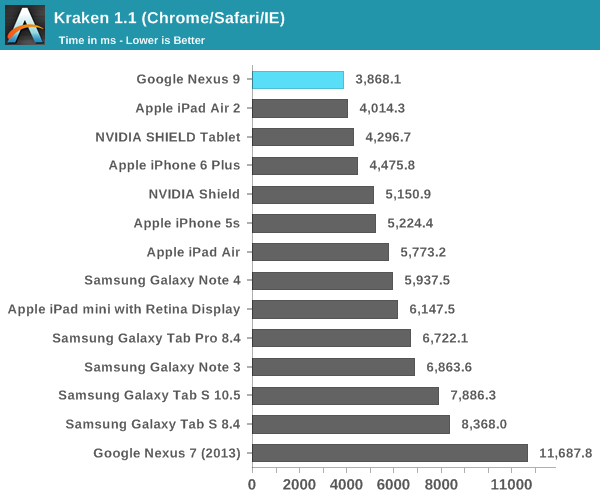

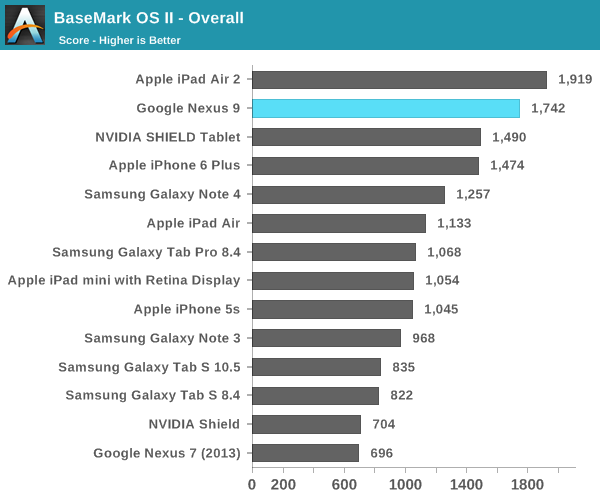
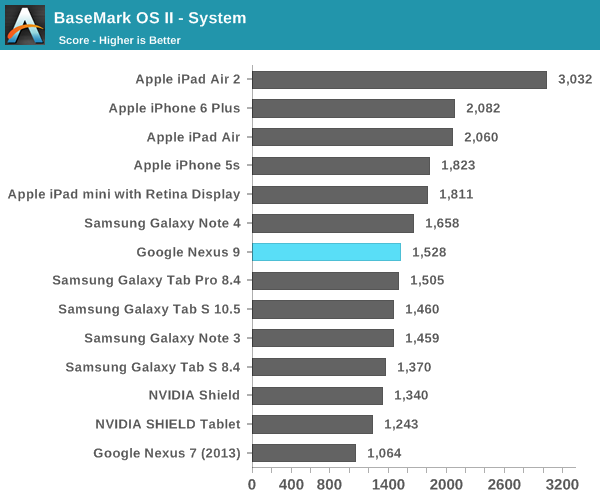
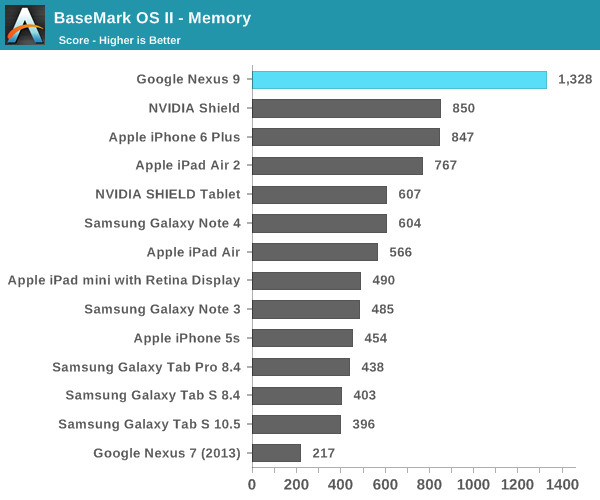
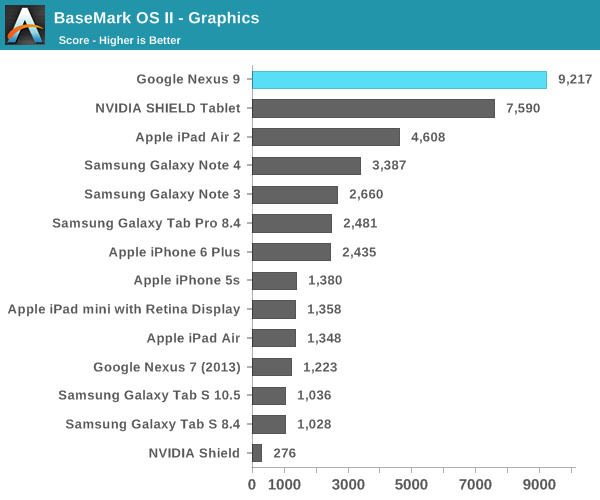
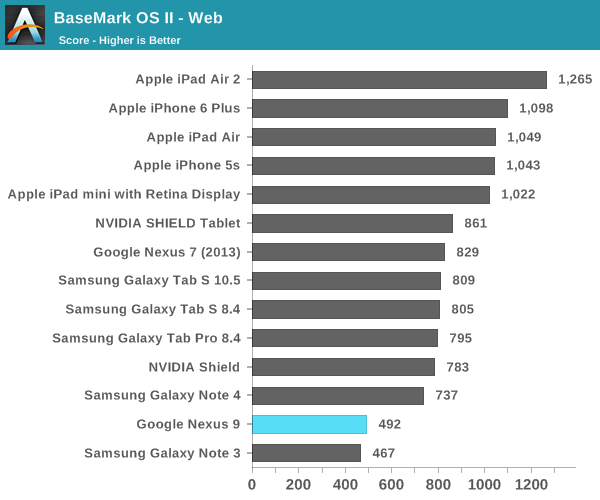
As one can see, at least at this stage in development the Nexus 9 can show some level of promise at times, but can be a bit disappointing in others. In SunSpider, Denver is generally even slower than Krait. However, in a benchmark like Kraken the Nexus 9 easily pulls ahead to take the top spot. In Basemark OS II the Nexus 9 does well overall but this seems to be due to its graphics performance/GPU performance and storage performance rather than CPU-bound tests like the system and web tests. It seems that when the code morphing systems works as expected, Denver can deliver significant amounts of performance. However, when such code morphing falls flat its true performance with a dual core, 2.3 GHz configuration is around that of a four Krait core CPU system at similar clock speeds. Once again, it's important to emphasize that this build is far from complete so performance should improve across the board with launch software. The fact that Tegra13x can approach A8X in CPU performance in some tests is definitely interesting to see.
Battery Life
While Denver's performance is a bit mixed, it's worth taking a look at battery life to see how Denver performs in these areas. As always, our battery life tests are all run with the display calibrated to 200 nits.
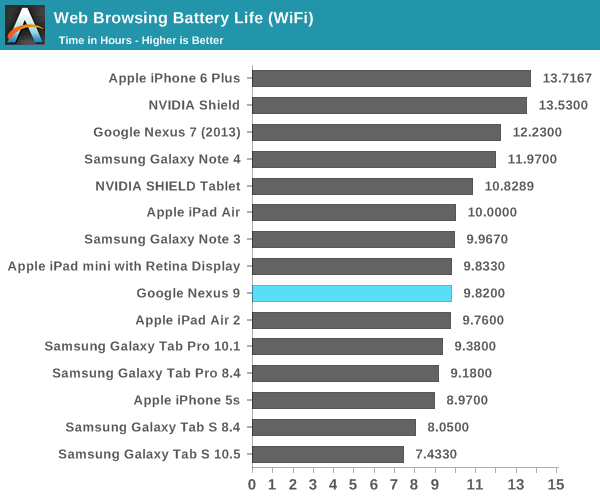
While an early build, it seems that the Nexus 9 is reasonably competitive in battery life but I'm not sure that these results are perfectly accurate. At any rate, efficiency at this stage seems to be par for the course, which should bode well for shipping software. This is a mostly display-bound test though, so we'll look at Basemark OS II to get a better idea for compute-bound battery life.
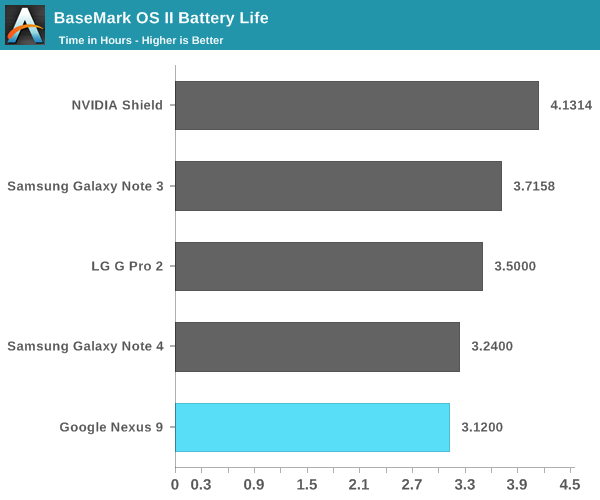

As one can see, while the battery life of the Nexus 9 ends up on the bottom for phablets and tablets, the overall performance during the test is quite high. We're working on a better comparison for the final review, but this should give a good idea of what to expect in general.










146 Comments
View All Comments
tuxRoller - Tuesday, November 4, 2014 - link
Pardon, that should've been relatively (as a linear function of screen area it comes to 176 mAh/in2 vs 163 for the ipad).As for the N4, well, I'd simply forgotten about it. However, we still don't have benchmarks for it in 64bit mode. As it is, it seems to be a bit slower than the a15 which shouldn't be the case.
chizow - Tuesday, November 4, 2014 - link
But the N9 has the brighter screen and a smaller battery, and yet N9 has slightly battery life. Not sure how you can be disappointed in this Nvidia effort when they have matched Apple's performance without needing to leverage 20nm and they have in most cases, doubled performance relative to the next closest Android ARM-based competitor and left Intel's Atom based offerings in the rear view as well. Cherry Trail might have proved an interesting part here, but its been delayed, so right now its clear there are really only two choices in the tablet SoC market for pure performance: A8X and Denver K1.testbug00 - Tuesday, November 4, 2014 - link
because the CPU and GPU use all the power in battery life tests, right? The brightness is not equalized, wifi doesn't draw power. Just the SoC.Oh, wait, the screens are standardized to 200nits brightness. And the bightlight is added to power, the wifi is adding to power, the digitizer is adding to power... Wifi tests using are not demanding, so, the SoC is more likely in a low power state, which, makes everything else besides the backlight take a lot more in terms of percentage than normally they would (backlight is still the largest power usage after SoC iirc, with a notable gap between those two and everything else)
Could it be possible that when you equalize the screen brightness (should be able equal power draw) that perhaps a larger screen matters more? Everything else should be about equal.
Low power usage for low power states of the SoCs, wifi radios about the same power, except, the iPad screen is ~29000mm^2, The Nexus 9 is about ~25500mm^2 on its screen.
Do you think that having about a 13% larger area to backlight would reasonably give under 1% less battery life given the battery is only 7% larger?
Apple's chip is likely more effective. The margin by which it is more effective is hard to tell without knowing what percentage of the power draw the tablets each had from the SoC. I would guess at least 15-20%. Which, would mean WORST CASE for Apple, Nvidia's chip's power consumption would be equal at the same node (more or less).
On that note, I think that a K1 A15r3 would likely be faster absolutely as a SoC. Granted, most things don't use 4 threads =]
tuxRoller - Tuesday, November 4, 2014 - link
The brighter screen doesn't matter as the test is done at the same brightness, and the runtimes differed by less than a minute.20nm doesn't make the performance any better unless you actually clock your cpus higher. Apple, iirc, only moved their clocks up 100MHz, to 1.4, while denver is running at 2.3.
I'm dissapointed b/c it looks like denver CAN be fast, but only if running one or two apps for long periods (filling the cache with that vliw optimized code). When multitasking it apparently has serious issues. Hopefully these can be addressed in future revisions to denver.
I'm not comparing denver to atom or other current android offerings as none of them have attempted to go use a radically different arch from everyone else.
DERSS - Wednesday, November 5, 2014 - link
"But the N9 has the brighter screen and a smaller battery, and yet N9 has slightly battery life" -- battery life is measured with equal brightness, so K1's longer battery life is result of smaller screen and dramatical throttling slowdown which is unavoidable since it is 28 nm process (versus 20 nm in A8X).kron123456789 - Wednesday, November 5, 2014 - link
What "dramatical throttling slowdown" are you talking about? Do you know what "throttling" means?DERSS - Thursday, November 6, 2014 - link
Yes, clock drops down to SoC not to overheat and to save battery life.testbug00 - Thursday, November 6, 2014 - link
in a web browsing test? The CPU isn't high enough to throttle... Or, if it is the webpage is more intensive than an 'average' mobile web page, OR, the SoC is terribly designed.While I am very down on Nvidia's mobile efforts due to peak power draws and throttling, it shouldn't be throttling anymore than the A8X in sane web browsing tests...
melgross - Monday, November 3, 2014 - link
We were being told that ARM could never compete with x86, but the A8x is stronger than most i3 low power chips. I assume this new Tegra is somewhere around that as well. The fact that it does compare with a three year old i5 notebook is something that I find incredible.Considering that Apple and possibly others, will continue to upgrade performance in their ARM offerings by substantially greater amounts than Intel is able to with x86, for at least the next few years, means that Intel really does have something to worry about.
kron123456789 - Monday, November 3, 2014 - link
Yeah, but here's what i think — iPad Air 2 and Nexus 9(and all Tegra K1 devices as well) has so much power and that power is used ONLY in benchmarks.